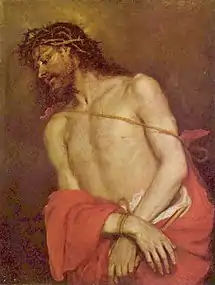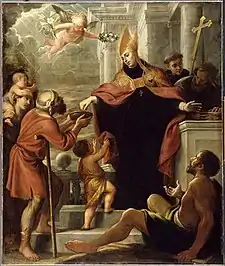Mateo Cerezo
Mateo Cerezo, sometimes referred to as The Younger (19 April 1637, Burgos – 29 June 1666, Madrid) was a Spanish Baroque painter; known primarily for religious works and still-lifes.


Life and works
His father was the painter, Mateo Cerezo Muñoz (c.1610-1670, sometimes referred to as The Elder), and Isabel Delgado, the daughter of a well-known goldsmith.[1] After receiving his initial training from his father, he went to Madrid, where he studied with Juan Carreño de Miranda, becoming one his most promising students. He was also employed in Carreño's workshops.
His style was influenced by Antonio de Pereda, Carreño and Bartolomé Esteban Murillo.[2] He also appears to have been familiar with Titian, Veronese and Correggio, whose works he could have seen in the Royal collections. He was active in Burgos, Valladolid and Valencia, as well as Madrid. His works ranged from altarpieces to small devotional paintings.
His final work was a "Last Supper" for the refectory of the Order of Augustinian Recollects, which is known only from a print by José del Castillo, made in 1778. It was looted during the Peninsular War, and passed through several hands before disappearing during the Spanish Civil War.[1]
He was married in 1664, and died two years later, as the result of an unspecified serious illness. Despite his early death, he left a relatively large body of works; many of which may be seen at the Museo del Prado.
Selected works
- Ecce Homo, 1650, Museum of Fine Arts, Budapest.
- Assumption of Mary (Asunción de María), c. 1650, Museo del Prado, Madrid.
- Desposorios místicos de Santa Catalina, Palencia Cathedral.
- The Assumption of Our Lady (La Asunción de Nuestra Señora), San Telmo Museoa, San Sebastián
- Magdalena penitente, c.1661, Rijksmuseum, Ámsterdam.
- Saint Francis Receiving the Stigmata, 1663, Chazen Museum of Art, Madison, WI
- Boda mística de Santa Catalina. Museo del Prado, Madrid.
- Bodegón de cocina. Museo del Prado, Madrid
- Una pobre alma ante el tribunal, Museo del Prado, Madrid.
References
Further reading
- Elias Tormo, Mateo Cerezo, Archivo Español de Arte y Arqueología (Spanish Art and Archaeological Archives). 3. 1927, pgs. 113 ff., 245 ff.
- Antonio Palomino, An account of the lives and works of the most eminent Spanish painters, sculptors and architects, 1724, first English translation, 1739, p. 89
- Juan Ruiz Carcedo, Maestros del arte burgalés (Masters of Burgalese Art). Burgos, 1997, p. 193-203 ISBN 84-7009-510-2
.jpg.webp)